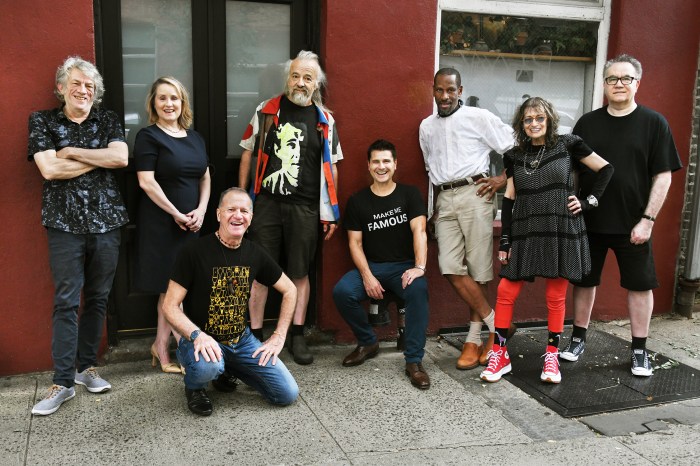By Ed Koch
“Where the Wild Things Are” (-)
The minus I give this children’s story pains me. As I have written many times, I don’t enjoy movies that can in any way be described as a cartoon/fable, which surely this film is. So I went to this movie somewhat prejudiced against it.
The picture is based on a book by Maurice Sendak, whom I know and admire. I once asked him to illustrate a children’s book that I was writing with my sister about my brother who was a great athlete, unlike me who was terrible at sports. He declined saying that his style and type of art would not be appropriate for our book.
The story is about a young boy, Max (Max Records), who lives with his loving mother (Catherine Keener) and his sister, a minor character in the film. Max runs away one night, crosses a body of water, and lands on an island where he meets a half dozen creatures who accept him as their king. Max doesn’t know that they have had other kings, all of whom they have eaten.
The animal characters, hybrids and scary in appearance, look like they had been on “The Island of Dr. Moreau.” The lead animal, Carol (voice of James Gandolfini), is really frightening. He constantly threatens to eat Max, but is sorry when he leaves the island. KW (voice of Lauren Ambrose) is a female of the same species. She saves Max from Carol by taking him into her mouth for a short while and then releases him.
If I had seen this film when I was eight, I would have been terrified. That did not seem to be the case with the youngsters in the theater when I saw the picture. I did not hear one child crying during the movie.
I saw the film with PA, who did not enjoy it, and with PB who did. I was advised by PT, who has not seen the film, that I would look and sound like a jerk if I criticized it. So, while I won’t disparage it, I must state that I did not enjoy it. After seeing the picture, my friends and I questioned what its moral was. No one could come up with one except for PT who said it was that a little boy could master his own savage emotions.
HG said he disliked the ending most of all, when Max’s mother on having her son home safe and sound, falls to her knees, hugs him, and gives him chocolate cake and milk. I said that was the only scene I loved. HG said, “She was too forgiving, and the kid will run away again.”
So, Maurice, while I didn’t enjoy the film, you did something quite brilliant. You got us all thinking and arguing about the movie which is no little feat.
Run time: 1 hour, 34 minutes. Rated PG. At, among other places, Regal Union Square Stadium 14 (850 Broadway; at 13th St.). For screening times, call 212-253-2225. For the Box Office, call 212-253-6266.
“Killing Kasztner” (+)
This brilliant documentary seeks to establish the hero status of Rudolf Kasztner. Kasztner bargained successfully with Adolf Eichmann to save the lives of 1,600 or more Jews, who were transported out of Hungary to Switzerland, and 19,000 Jews who were sent to work camps instead of death camps. Shortly before the end of World War II, Eichmann successfully arranged for the killing of near 600,000 Hungarian Jews.
Kasztner ends up in Palestine under the British, ultimately becoming a member of the Ben-Gurion government in the new state of Israel. He is called a collaborator by another Israeli who is then sued by the Israeli government for libel. The judge hearing the case believes Kasztner lied about certain documents and finds the alleged slanderer of Kasztner not guilty. Ultimately the Israeli Supreme Court reverses the judgment, but Kasztner’s reputation is never fully restored.
The documentary spectacularly sets forth what occurred and establishes, to my satisfaction, that Kasztner was a hero. Kasztner is killed shortly after the first trial finding him to be a collaborator. His assassin, who is presented in the film, comes to the conclusion that he was wrong. He now believes that Kasztner was a hero bargaining with the Nazis to release Jews in exchange for money — $1000 for each Jew.
The movie contains a number of enthralling vignettes. One of those is about the Satmar’s founding rabbi, Joseph Teitelbaum, who was saved by Kasztner by being placed on the train to Switzerland. When asked to appear at the Israeli Court on behalf of Kasztner, he refused saying that Kasztner did not save him, God did. The Satmar, one of the largest Hasidic groups in New York City, is centered in Williamsburg, Brooklyn.
“Killing Kasztner” will cause you to weep, although there are no concentration camp scenes at which six million Jews died. As far as the world is concerned, the Holocaust appears to be slipping into ancient history, like the days of Rome and Athens.
I urge everyone, Jew and Gentile, to see this film and meet the surviving family members of Rudolf Kasztner, particularly his wife and daughter. It is playing at the Cinema Village. The theater was near full when I went, and the audience appeared to consist of elderly Jews, some of whom may have been survivors.
Run time: 116 minutes. Unrated. At Cinema Village (22 East 12th Street, between Fifth Avenue and University Place). For screening times, call 212-924-3363.



































